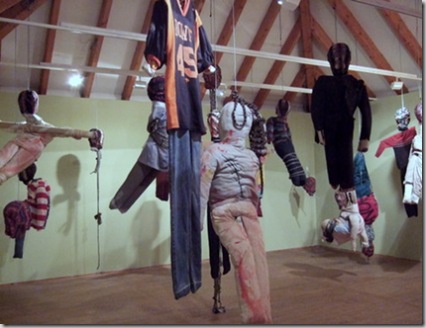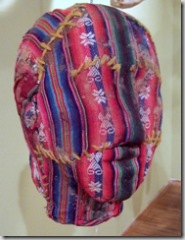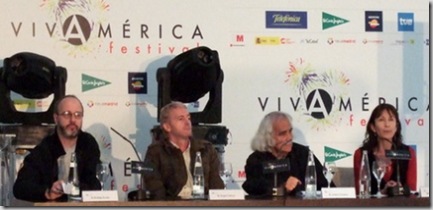
Saturday began at the African Cultural Centre, where Benji Francis presented the raw work by nine young performers who each told the story of their lives for the first time to an audience. These were ordinary stories of people in townships. One was a boy who had shot his stepmother after daily beatings. Another was a girl whose best friend overdosed from drugs she had sold her. Another boy’s parents had died in a car accident and was then caught up in the crime world in order to survive.
But the most dramatic story was the girl whose teacher had thrown a rock at her for coming to school while they were still on strike. The police had returned soon after and tried to disperse the teachers with guns. She fled the shooting and hid at home. The police eventually knocked on her door and uncovered her hiding. They then commanded her to stand with her back to them while they shot her mother. When her uncle turned up, he raged against them and threw rocks. By that stage they had run out of rubber bullets and shot him dead with real bullets.
I asked this girl, Linda, if she knew why the police were shooting, and she seemed to have no idea. While the tragedy of her uncle’s death was bad enough, the absence of any political context to it was quite shocking. Why were the teachers striking? Or perhaps it was a very different response to lack of social services. Talking to Benji Francis afterwards, I leant that many of these police were white Afrikaaners. So what has changed since the end of Apartheid?
This morning’s performance was graced with the presence of the first lady, Zanele Mbeki, a great supporter of South African craft. The young actors seemed unfazed by this official presence. Mrs Mbeki was very gracious and commended the actors, saying that their performance opened her eyes to the problems that still beset South Africa. The reluctance to delve further into the shooting at Protea South might have been due to an concern not to embarrass the first lady.
We walked out of the theatre for a lunch of chicken biyrani. Almost immediately, we were entertained with a troup of jive dancers from the Katherus township. Their dancing was amazingly energetic and infectious. The stories we had just been privy to gave us as a sense of the individual challenges that township children face. It was very moving to be immediately hit by this wall of energy, showing an immense capacity to overcome tragedy and keep moving.
I then moved with my group to the Bus Factory for the craft workshop. As we entered the building, we were greeted by women in traditional Zulu costume who were singing and dancing. We were handed programs that listed us as official guests. No one had told us. It was the official re-launch of the Craft Council of South Africa, which has just undergone a black empowerment revolution.
I was asked to the platform and made some remarks on south and craft. I kept my comments short as there was a translator, Mamma G, who put my English into Zulu. While my sentences were short, her translations seemed to go on much longer. I learnt afterward that she made her own speech in response to mine. While I might have said, ‘It is important for crafters to understand the gallery’, Mamma G would say that ‘You must listen to this important message and take your work seriously. You need to value your work more and stop being so lazy.’ It seemed to go well enough, and we played a small but fraught part in the new organisation.
The workshop was challenged by sound problems, but it worked well enough in the end. There were an interesting variety of participants, from crafters to government trainers. We ended up focusing on the pragmatics of exhibition, talking about how someone might create a gallery of their own rather than wait to be invited into someone’s stable.
After a drink in Newtown, we made our way back to Soweto for the live coverage of the Rugby World Cup between South Africa and England. Apparently the South African President Thabo Mbeki had encouraged his team by telling them that they were in Paris not just representing themselves, but they were ‘representing all countries of the south.’ In his ANC letter of the week, Mbeki writes:
I also know that the Springboks know that they will walk into the Stade de France, on 20 October, carrying the hopes and best wishes of the rugby nations of the South, who sent their best fighting squads to France to bring the Webb Ellis Cup back to the South, away from its temporary sojourn in the North.
(ANC Today Vol.7 No. 41, 19 October 2007)
What a perfect drama for the South Project in Johannesburg, otherwise known as Mzantsi (‘south’).
We found ourselves in the local Soweto shabeen with a couple of hundred others drinking around a projector that was beaming the game onto a screen. I had thought that rugby was a white man’s sport, so it was surprising to see a largely black crowd getting so excited about a white game. The broadcast was part Afrikaans. They seemed to start speaking English, but lapse into Afrikaans when the action became too exciting. When the game finally finished, there was mayhem in the shabeen. Everyone got up onto the tables and started dancing. They kept up the rhythm for hours. Sometimes, the audience would erupt into live singing over the top of the recorded music. The excitement of victory was so powerful.
The conversation around the evening was to do with how rugby has been embraced by blacks. The amabokaboka (the people of the Springboks) seemed to completely identify with this white team.

The day began with stories of seemingly hopeless struggle, and ended with a great collective celebration. We heard from Zanele Mbeki in the morning about the need to attend to individual hardships, and then saw Thabo Mbeki in the evening celebrating his country’s triumph on the world stage.
That’s South Africa.
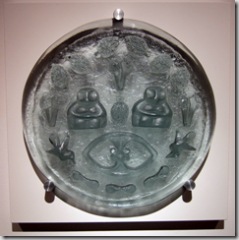

 First thing this morning Clifford Charles dropped into the B&B and we went for a walk over the rocks. He told me that the South African reggae star Lucky Dube had been
First thing this morning Clifford Charles dropped into the B&B and we went for a walk over the rocks. He told me that the South African reggae star Lucky Dube had been 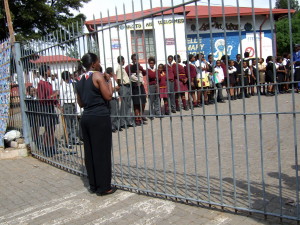
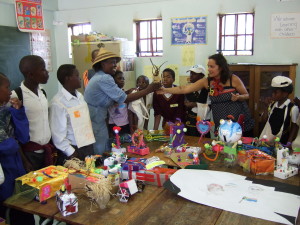
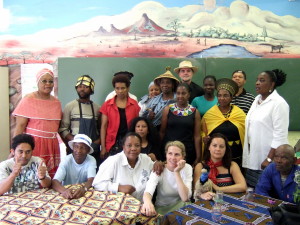
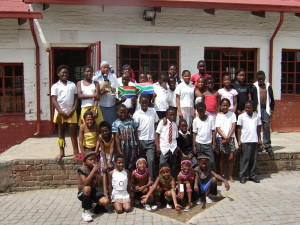
 I caught a taxi from Bree Street taxi centre in downtown Joburg. It was like a massive car park filled with taxis weaving in between queues of commuters.
I caught a taxi from Bree Street taxi centre in downtown Joburg. It was like a massive car park filled with taxis weaving in between queues of commuters. 